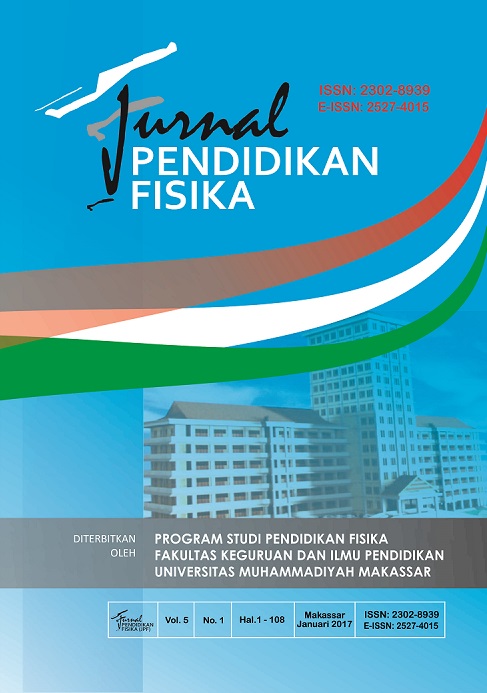Peranan Software Adobe Captivate Untuk Meningkatkan Hasil Belajar Fisika Pada Peserta Didik Kelas VIIIA SMP Negeri 5 Pallangga Gowa
DOI: https://doi.org/10.26618/jpf.v5i1.340
Abstract
Penelitian ini bertujuan untuk mengetahui peranan Software Adobe Captivate terhadap peningkatan hasil belajar peserta didik kelas VIIIa SMP Negeri 5 Pallangga Gowa. Desain penelitian yang digunakan adalah “One-Shot Case Study Design”. Populasi dalam penelitian ini adalah seluruh peserta didik kelas VIII SMP Negeri 5 Pallangga Gowa Tahun Ajaran 2011/2012 yang berjumlah 167 orang terdiri dari empat kelas. Sampel dalam penelitian ini adalah kelas VIIIa yang terdiri dari 40 orang yang ditentukan melalui pengacakan kelas dengan asumsi bahwa seluruh kelas adalah homogen. Data hasil penelitian diperoleh melalui tes hasil belajar IPA. Tehnik analisis data menggunakan uji normalitas dan uji hipotesis “uji Z”, dari hasil analisis tersebut diperoleh hasil belajar peserta didik kelas VIIIa SMP Negeri 5 Pallangga pada aspek koginitif, afektif dan psikomotorik dalam kategori tinggi.
Kata kunci: : Software Adobe Captivate dan Hasil belajar IPA.
This study aims to determine the role of Software Adobe Captivate to improving the learning outcomes of students VIIIA grade SMP Negeri 5 Pallangga Gowa. The study design used is "One-Shot Case Study Design". The population in this study were all students of class VIII SMP Negeri 5 Pallangga Gowa Academic Year 2011/2012 of 167 people consisting of four classes. The sample in this study is VIIIA class consisting of 40 people was determined by randomization class with the assumption that the whole class is homogeneous. The data was obtained through the test results to learn science. Technical analysis of the data using normality test and test hypotheses "Z test", the results of the analysis obtained by the study of students VIIIA grade SMP Negeri 5 Pallangga on aspects of a cognitive, affective and psychomotor in the high category.
Key words: Software Adobe Captivate and learning outcomes IPA.
References
Munir. 2008. Kurikulum berbasis teknologi informasi dan komunikasi. Bandung: Alfabeta.
Yusuf, H, dkk. 1986. Teknologi komunikasi pendidikan. CV Rajawali: Jakarta.
McLuhan,Marshall.2001.Understanding Media.London: Routledge.
Sadiman, Arif S. 2003. Media Pendidikan: Pengertian, pengembangan dan Pemanfaatannya. Jakarta :PT Raja Grafindo Persada.
Arifin, et al.2003. Strategi Belajar Mengajar Kimia. Common Text Book (edisi revisi).Bandung : Jurusan Pendidikan Kimia FPMIPA UPI
W.S.WINKEL.2004.Psikologi Pengajaran. Yogyakarta: Media Abadi
Ratumanan, T.G. 2004. Belajar dan Pembelajaran.Semarang :Unesa University Press
Haling, Abdul. 2006. Belajar dan Pembelajaran. Makassar: Badan Penerbit Universitas Negeri Makassar.
Nana Sudjana.2010. Dasar-dasar Proses Belajar, Sinar Baru Bandung.
Ekawarna. 2009. Penelitian Tindakan Kelas. Jakarta : GP. Press
Downloads
Published
How to Cite
Issue
Section
License
Copyright:
Authors who publish with this journal agree to the following terms:
1. Authors retain copyright and grant the journal right of first publication with the work simultaneously licensed under a Creative Commons Attribution-ShareAlike 4.0 International License that allows others to share the work with an acknowledgement of the work's authorship and initial publication in this journal.
2. Authors are able to enter into separate, additional contractual arrangements for the non-exclusive distribution of the journal's published version of the work (e.g., post it to an institutional repository or publish it in a book), with an acknowledgement of its initial publication in this journal.
3. Authors are permitted and encouraged to post their work online (e.g., in institutional repositories or on their website) prior to and during the submission process, as it can lead to productive exchanges, as well as earlier and greater citation of published work.
Licence:
Authors are free to:
1. Share: Copy and redistribute the material in any medium or format
2. Adapt: Remix, transform, and build upon the material for any purpose, even commercially.
The licensor cannot revoke these freedoms as long as the authors follow the license terms, which include the following:
1. Attribution: You must give appropriate credit, provide a link to the license, and indicate if changes were made. You may do so in any reasonable manner, but not in any way that suggests the licensor endorses you or your use.
2. ShareAlike: If you remix, transform, or build upon the material, you must distribute your contributions under the same license as the original.
3. No additional restrictions: You may not apply legal terms or technological measures that legally restrict others from doing anything the license permits.
Jurnal Pendidikan Fisika is licensed under a Creative Commons Attribution-ShareAlike 4.0 International License.






